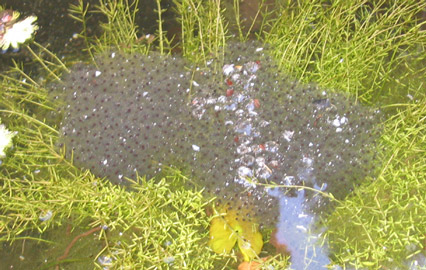Frog Blog Week 2 – Tiny Black Dots – no movement yet
We have been keeping a careful watch on the frog spawn in the office pond. The frogs spawned for the first time in our pond last Sunday, so we have decided to keep an observational record of how the tadpoles get on. Four frogs were in the pond, we suspect one female and three males. Identifying males and female frogs is not our strong suit, but we estimated the ratio of boys to girls based on the fact that one frog was bigger than all the rest, so we speculated that this was the female.
During the breeding season, the male frogs develop pronounced dark pads on their first digits of the hand. These pads are present all year round but swell up in the breeding season and help permit males to grip the usually larger females during mating.
Also, the smaller frogs croaked and we think that only the males do this. The sound does not carry very far, it is certainly not the loudest frog croaking we have heard, many tropical frogs would easier drown out the noise made by these Common Frogs as these animals lack a vocal sac to help the sound resonate.
By Monday the pond was empty and the adult frogs had left, perhaps to hunt in the surrounding rockery, we did not expect to see all four of them together again, but surprisingly on Wednesday all four frogs (one big one and three smaller ones) returned to the pond and there was a lot of activity again but no further spawning.
Frog Blog – Week 2

Picture credit: Everything Dinosaur
The weather in the north-west of England has been particularly cold over the last few days. We have experienced strong gales, hail storms and even some snow. This is the earliest Easter for 95 years, we suspect that the development of the eggs will be dependent on the water temperature, so it may take a while for the embryos to start to develop. The jelly surrounding the tiny black dots (each no more than about 2mm across), has swollen and this helps the spawn stay afloat and close to the surface of the pond. In this way the spawn can be warmed by sunlight to the greatest extent (surface water of ponds tends to be warmest).
We have been concerned this week, as there has been a lot building work going on around us and the construction teams have lit several bonfires. This has led to large deposits of ash and other debris getting blown into the pond. The silvery “scum” surrounding some of the spawn that can be seen in the picture, is ash that has drifted into the pond, we are not sure what effect this pollution will have on the spawn’s development.
We will have to keep you posted on the spawn’s progress…
Science Bit
Amphibians were the first truly semi-terrestrial animals, evolving in the late Devonian and becoming more numerous and diverse during the Carboniferous and Permian periods before suffering in the Late Permian mass extinction. At the end of the Permian there were about 35 known families of amphibians, many of them considerably larger than their modern counterparts. After the mass extinction event, at the beginning of the Triassic (248 million years ago), there were about 10 families remaining.
About 70 percent of all the types of amphibians around at the time of the Late Permian went extinct. Today, there are about 4,300 species of amphibians in the world (mostly frogs), but the amphibian class has never fully recovered from the Permian mass extinction. Amphibians were at their most diverse (in terms of families) and spectacular something like 50 million years before our ancestors (the first mammals) evolved.






Leave A Comment